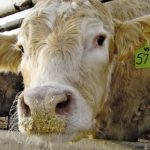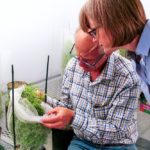A significant amount of nitrogen applied to fields is never taken up by plants. Understanding how much nitrogen (N) crops actually need can help decrease needless expenses and potential environmental […] Read more
Tag Archives university of saskatchewan

Getting the most efficient nitrogen use
Soil testing is vital to identify where nitrogen is needed

Wheat’s bigger future
New genetic tools are emerging after the sequencing of the wheat genome
The sequencing of the wheat genome means researchers will finally have access to genetic tools to help with wheat development — an advantage other crops have had for years. It […] Read more

Research focuses on flooring design as possible disease cause
Toe tip necrosis syndrome often misdiagnosed, and likely more common than had been thought: vet researcher
Toe tip necrosis syndrome (TTNS), a disease that causes lameness in the hind feet of cattle, has been overlooked for years said a veterinary researcher. “I think the disease has […] Read more

The far-reaching effects of rumen acidosis
It is a painful condition caused by eating too much highly digestible starch or sugar and can also decrease performance
Ruminal acidosis can be a painful condition for cattle and could lead to other problems like ruminitis, laminitis or liver abscesses. Acute acidosis can occur when cattle consume too much […] Read more

Managing poultry euthanasia
A large research project is looking at how farmers can finetune the humane death of poultry on their farms
Poultry producers across North America should soon have access to expert advice about the most practical, effective ways to deal with euthanasia on their farms. Why it matters: In both […] Read more

Animal science professor Red Williams, 93
Memorial services will be held “at a later date” for renowned Prairie animal science professor Charles “Red” Williams, who died Monday at age 93 leaving a legacy of work in […] Read more

U of S research reveals controversial insecticides are toxic to songbirds
Saskatoon – Research at the University of Saskatchewan (U of S) has linked the use of insecticides to serious health issues in songbirds. “Studies on the risks of neonicotinoids have […] Read more

Crop research partnership maps two lentil genomes
A partnership between University of Saskatchewan (U of S) crop scientists and genomic big data company NRGene of Israel has successfully sequenced two wild lentil genomes—the largest legume genomes ever […] Read more

Alberta to reallocate veterinary school funding
Alberta is set to gradually pull its $8 million in annual funding from the University of Saskatchewan’s Western College of Veterinary Medicine (WCVM) and instead expand the vet school at […] Read more

Field testing underway on Canadian PED vaccine
Field testing is underway and a corporate partner on board for development of a made-in-Saskatchewan vaccine to protect pigs against porcine epidemic diarrhea (PED). The University of Saskatchewan’s Vaccine and […] Read more
